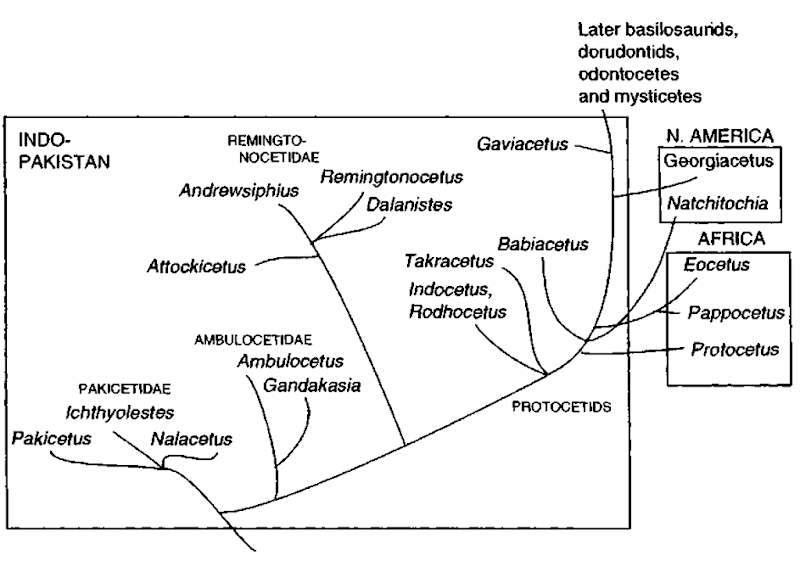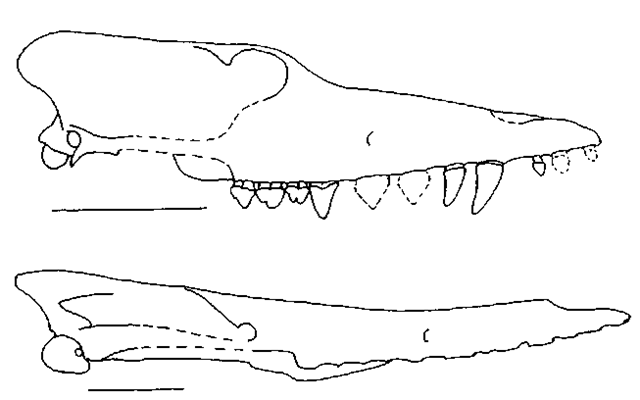Archaeocetes is the common name for a group of primitive whales that lived in the Eocene Period (approximately 55-34 million years ago). Archaeocetes are important because they represent the earliest radiation of cetaceans and because they include the ancestors of the two modern suborders of cetaceans (Mysticeti and Odontoceti), Archaeocetes are also the main source of information about the great moqahological changes that were associated with the acquisition of aquatic features in cetaceans; archaeocetes document the initial amphibious stages in cetacean evolution [for a semipopular account, see Zimmer (1998)]. Six families of cetaceans are commonly included in archaeocetes : Pakicetidae, Ambulocetidae, Remingtonocetidae, Protocetidae, Basilosauridae, and Dorudontidae. Basilosaurids and dorudontids are discussed separately, and the remaining four families are treated here. Williams (1998) discussed the taxonomy of these archaeocetes.
I. Pakicetidae
Pakicetidae are only known from the early-to-middle Eocene and lived approximately 50 million years ago in India and Pakistan. Dozens of fossils of pakicetids are known, but none consist of complete skeletons. Known skeletal elements of pakicetids include mainly skulls, teeth, and jaw fragments. The smallest pakicetids were as small as a fox, with the largest as large as a wolf. The dentition of pakicetids varied greatly: the smaller species had teeth that resemble those of modern fish eaters, and teeth of the largest pakicetids resemble those of hyenas in some respects. Pakicetids may have been predators or carrion feeders. The nasal opening of pakicetids was near the front of the head, and the eyes faced dorsally, similar to crocodiles (Fig. 2). Pakicetids had small brains flanked by enormous chewing muscles. The skull and dentition of pakicetids do not resemble those of modern whales and dolphins, but the ear of pakicetids clearly shows that they were cetaceans: there is a sigmoid process, an involucrum, and ear ossicles that are pachyostotic and rotated ( Hussain, 1993). Pakicetid fossils are only found in freshwater deposits and most are known from deposits that represent shallow ephemeral streams in an arid climate, which makes it unlikely that pakicetids were good swimmers. Three genera are included in Pakicetidae: Fakicetus, Ichthyolestes, and Nalacetus.
Figure 1 Phytogeny of early and middle Eocene cetaceans, indicating on which continent each of the families occurred, Protocetids is considered a paraphyletic group, and Gaviacetus is not considered a protocetid.
Figure 2 Reconstructed skulls of Pakicetus and Remingtono-cetus. No teeth are indicated for Reniingtonocetus, as their morphology is poorly known. Scale bars are 10 cm.
II. Ambulocetidae
Ambnlocetids are known from middle Eocene rocks in northern India and Pakistan. There are fewer than 10 described am-bulocetid fossils, but one of these consists of a nearly complete skeleton of a single individual of Ambulocetus natans. This skeleton is a prime source of information about early cetacean biology. Ambulocetus was similar in size to a large male sea lion. It had a large head, with a long snout and eyes that were dorsal on the skull, but faced laterally. The teeth are robust and strongly worn. Skull and vertebrae indicate that the muscles of the head and neck were strong, indicating that Ambulocetus was a powerful animal. The shape of the lower jaw of Ambulocetus, unlike that of the pakicetids, shows that there was an unusual soft tissue connection between the back of the jaw and the middle ear. In modern odontocetes, this connection consists of a large fat pad that functions as part of the sound-receiving system. This connection is small in Ambulocetus and was probably not as important functionally as it is in modern cetaceans. It does show that hearing adaptation arose early in cetacean phylogeny. Ambtdocetus had a back that was strong and muscular, and the tail was long and lacked flukes. The hindlimbs were relatively short, but the feet were long, and there were four toes. The long paddle-shaped feet indicate that it swam like a modern otter, by swinging its hindlimbs through the water and creating additional propulsive force with its tail (Fish, 1997). The forelimbs were short, with five fingers that each terminated in a short hoof. The hands were much shorter than the feet. The skeleton of Ambtdocetus indicates that it was probably slow on land. Ambulocetus was probably an ambush hunter, attacking prey in or near shallow water. This method of hunting is used by modern crocodiles.
Ambulocetus is only known from nearshore marine environments, including estuaries or bays. Geochemical analyses of anr-bulocetid bones indicate that it drank a mixture of fresh and sea-water and that different individuals may have inhabited different microenvironinents (Roe et al, 1998). Genera included in Ambulocetidae are Ambtdocetus, Gandakasia, and Himalatjacetus.
III. Remingtonocetidae
Remingtonocetids are only known from India and Pakistan, from sediments approximately 46 to 43 million years old.Dozens of remingtonocetid fossils have been described, but most of these document only the morphology of skull and lower jaw (Fig. 2). Dental and postcranial remains are scarce. The smallest remingtonocetids may have been as small as Fakicetus, and the largest may have been close in size to Ambubcetus. All early cetaceans had long snouts, but those of remingtonocetids are proportionally even longer than those of other archaeocetes. Skull shape varied between different remingtonocetid genera and possibly reflected different dietary specializations. In Andretvsiphius the snout is very narrow and high, and the chewing muscles are weak, suggesting that it may have eaten small, slippery fish. In Remmgfonocettts, the snout is rounded and robust, and the chewing muscles are lar ge, as would be expected in an animal that attacks larger, struggling prey. No remingtonocetid displays the robust masticatory morphology of Ambulocetus. The nasal opening of remingtonocetids is near the front of the skull, similar to pakicetids. Tire eyes are small, unlike ambulocetids and protocetids. The ear of remingtonocetids is larger than that of pakicetids and ambrrlocetids, and tire connection between the lower jaw and the ear is larger than in ambulocetids. The ears are also set far part, possibly to increase directional hearing. These features are consistent with an increased emphasis on underwater hearing in remingtonocetids.
The postcranial morphology of remingtonocetids is only known from fragmentary specimens. These indicate that the neck was long and mobile and that the hindlimbs were large and that remingtonocetids were certainly able to support their body weight with their limbs, similar to ambulocetids (Gin-gerich et al, 1995).
Figure 3 Skeleton of Ambulocetus. Scale bar is 20 cm.
Figure 4 Skeleton of the protocetid Rodliocetus.
The most primitive and oldest remingtonocetid (Attockice-ttis) is found in the same deposits as Ambuloeetus. The other remingtonocetids are known from marine, nearshore deposits and may have lived in bays and saltwater swamps. Stable isotope geochemistry indicates that remingtonocetids ingested seawater (Roe et al., 1998). Remingtonocetid genera include Remingtonocetus, Andrewsiphius, Attockieetus, and Dalanistes.
IV. Protocetidae
Protocetids are found in middle Eocene rocks in Indo-Pak-istan, Africa, Europe, and North America. They are the oldest whales to disperse across the oceans, although they probably only inhabited the warm seas near the tropics. Many protocetid genera are known, and several of these include several partial skeletons (Fig. 4) (Hulbert et al, 1998). Protocetids are diverse; their average size was somewhat smaller than Ambuloeetus.
Protocetids had long snouts, large eyes, mid their nasal opening was farther caudally than in earlier archaeocetes. This suggests that protocetids could breathe while holding much of their head horizontally, similar to modern cetaceans. It foreshadows the origin of the cetacean blowhole. The teeth of protocetids vary between genera, but there is trend toward the reduction of occlusal basins on the teeth. Basins on the teeth of primitive mammals, including pa-kicetids and ambulocetids, are an essential part of chewing morphology. Modem cetaceans do not chew and lack basins, and protocetids show an early stage in the reduction of masticatory function of the teeth. It is likely that protocetids were active hunters of marine animals, possibly similar to modern pinnipeds. Protocetid locomotor morphology was varied. In general, the tail is well developed and was probably involved in creating propulsive forces (Buch-holtz, 1998). The hindlimbs are reduced, and in some species the innominate is not connected by bone to the vertebral column, suggesting that the hindlimb did not support the body weight. There are no fossils that document all of protocetid liindliinb morphology, but some preserved elements suggest that the hindlimbs were short. Indo-Pakistani protocetids inhabited the same environments as the remingtonocetids, and protocetids from other continents are known from shallow marine environments. Known genera of protocetids are Protocetus, Babiacetus, Eocetus, Georgiacetus, Indocetus, Natchitochia, Pappocetus, Rodhocetus, and Takracetus.
These archaeocete families document that the Eocene cetacean evolution is characterized by increasing aquatic adaptations, starting at amphibious early whales (pakicetids, ambulocetids) to more marine protocetids. Late Eocene whales (Dorudontids, basilosaurids) were probably obligate marine mammals.




